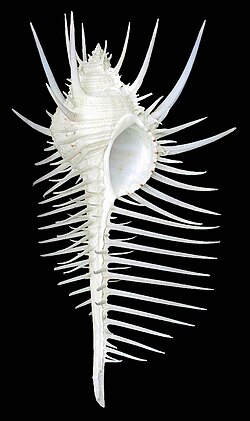| Murex Temporal range: | |
|---|---|
 | |
| Apertural view of the shell of Venus comb murex, Murex pecten, anterior end towards the bottom of the page | |
| Scientific classification | |
| Kingdom: | Animalia |
| Phylum: | Mollusca |
| Class: | Gastropoda |
| Subclass: | Caenogastropoda |
| Order: | Neogastropoda |
| Family: | Muricidae |
| Subfamily: | Muricinae |
| Genus: | Murex Linnaeus, 1758 |
| Type species | |
| Murex tribulusLinnaeus, 1758 | |
| Synonyms [1] | |
| |
Murex is a genus of medium to large sized predatory tropical sea snails. These are carnivorous marine gastropod molluscs in the family Muricidae, commonly called "murexes" or "rock snails". [1]
Contents
- Etymology
- Fossil records
- Distribution
- Habitat
- Shell description
- Human use
- Species
- References
- External links
The common name murex is still used for many species in the family Muricidae which were originally given the Latin generic name Murex, but have more recently been regrouped into newer genera. Murex was used in antiquity to describe spiny sea snails, especially those associated with the production of purple dye. Murex is one of the oldest classical seashell names still used by the scientific community.
Aristotle described these mollusks in his History of Animals using the Greek term πορφύρα (porphyra). [2]

